Exploring Wakeboard Cable Parks: A Comprehensive Guide
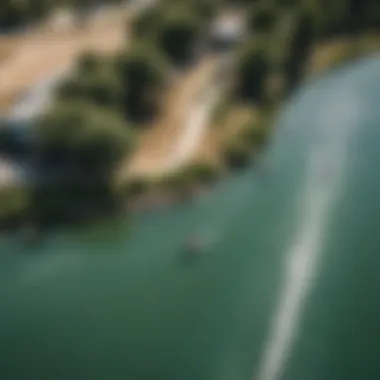
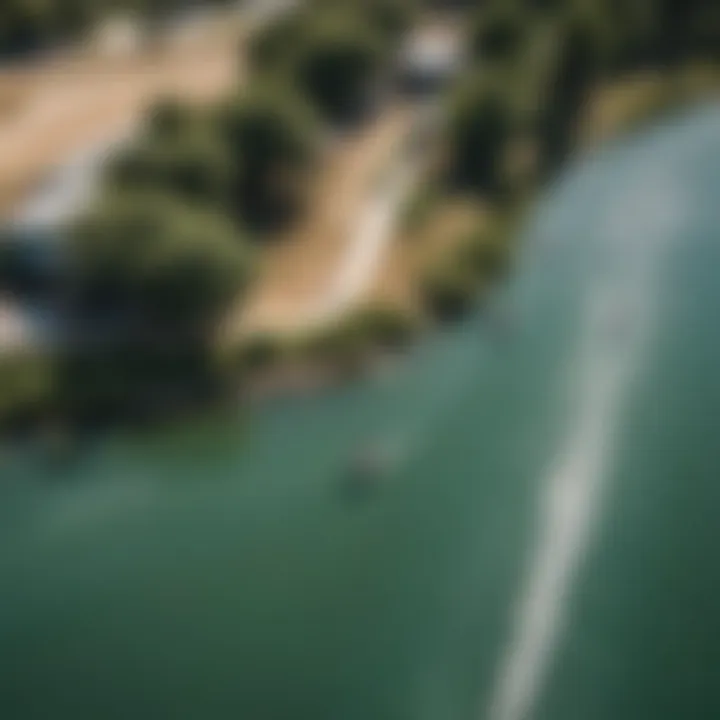
Intro
In recent years, the emergence of wakeboard cable parks has significantly transformed the landscape of watersports. These parks have swiftly gained popularity among enthusiasts, offering a unique blend of thrilling adventure and accessible learning environments. Unlike traditional wakeboarding behind a boat, cable parks provide a controlled setting that can accommodate various skill levels, from curious beginners to seasoned pros. As the sun shines over a tranquil lake, the rippling water acts as a perfect canvas for riders to carve their way through challenging features and ramps.
But what truly makes cable parks stand out? This guide seeks to illuminate the key features, advantages, and practical insights about wakeboard cable parks. You will learn about selecting the right spot for your next adventure and the array of activities these parks offer. So, buckle up and prepare to dive into this exciting waterborne world, whether you're hopping onto a board for the first time, or trying to master that next big trick.
Gear Essentials
To fully enjoy what wakeboard cable parks offer, equipping yourself with the right gear is not just a good idea but a necessity. Having the right equipment is like bringing a knife to a gunfight; you really want to be prepared.
Top Picks for Watersports Equipment
Here’s a rundown of essential gear you’ll need:
- Wakeboard: The heart of your ride. For beginners, a wider board can provide more stability, whereas experienced riders might opt for a narrower, more maneuverable option. Brands like Hyperlite and Liquid Force foster a range of options for every level.
- Bindings: Match them to your board for optimal performance. Adjustable bindings ensure that you can accommodate growth or changes in comfort preferences. A well-fitted binding translates into better control on the water.
- Helmet: Safety first! A good-fitting helmet can protect against bumps and falls, especially when navigating obstacles.
- Impact Vest: Not your average life jacket; impact vests are designed to protect your torso while allowing flexibility.
Equipping yourself smartly doesn’t just enhance your riding experience; it also keeps you safe.
Maintenance and Care Tips for Gear
- Cleaning Your Board: After every session, rinse your board with fresh water to remove salt and dirt. This will prolong its life.
- Dry Bindings: Always let your bindings air dry after use; moisture can lead to mold and deterioration.
- Check for Damage: Regular inspections can save you from unexpected malfunctions when you’re out on the water.
"Taking proper care of your equipment can enhance its lifespan and your overall experience."
Techniques and Tips
Beginner Tips for Each Watersport
Starting out at a cable park can feel overwhelming, but don’t let that deter you. Here are a few tips to get you rolling:
- Start Slow: Take some time to familiarize yourself with the park features. Practice going straight and getting comfortable with the pull from the cable.
- Body Positioning: Keep your knees slightly bent and your weight centered. This will balance your ride and reduce the chances of falling.
Advanced Techniques for Skill Enhancement
Once you have the basics down, consider introducing some tricks to your repertoire. For more seasoned riders, here are some techniques that might elevate your game:
- Riding Switch: This challenge will improve your balance and adaptability.
- Jumps and Spins: Work on your launching technique before attempting advanced tricks. Jump off the wake, and use your body to initiate spins.
In a nutshell, whether you're just starting or trying to boost your skills, there's room for everyone at a wakeboard cable park. With the right gear and a bit of know-how, you're bound to have a blast out on the water.
Understanding Wakeboarding
Wakeboarding has become one of the most exhilarating watersports in recent years. Grasping the fundamentals of wakeboarding not only enhances riding skills but also enriches one’s experience at cable parks. With its combination of balance, agility, and style, wakeboarding captures the essence of water-based activities that offer fun along with a fitness element. Understanding wakeboarding is like learning the ABCs before writing a novel; it lays a crucial foundation for anyone eager to explore cable parks.
The Basics of Wakeboarding
At its core, wakeboarding is riding a board while being towed behind a boat or cable system. This seemingly simple concept holds a wealth of techniques and tricks that can leave newcomers floundering without a clear understanding. When starting, having the right stance on the board is vital; usually, riders adopt either a regular stance (left foot forward) or a goofy stance (right foot forward).
For beginners, focusing on balance is significant. Many riders find themselves falling flat on their face during those initial tries, and that’s part of the learning curve. In the world of wakeboarding, practice truly makes perfect. Practicing gets them used to the feel of the board slicing through the water.
Furthermore, the use of a wakeboard-specific life jacket and good bindings greatly enhances safety and performance. In addition to equipment, riders must learn about the way wakes are formed and how to use them for tricks. This foundational knowledge transforms a ride into a spectacular display.
The Evolution of Wakeboarding
Wakeboarding didn’t sprout overnight; it has a rich history that traces back to the early ‘80s. Initially stemming from a combination of surfing, water skiing, and even skateboarding, it represents a fusion of different worlds. Early enthusiasts took to the waters using skurfboards—boards meant for surfers who wanted to enjoy the thrill of being towed.
As the sport progressed, the introduction of the wakeboard revolutionized the methodology of riding.* It is lighter and has a different shape, allowing for more tricks and a unique style of riding.* In fact, the first competitive wakeboarding event was held in 1985, marking a pivotal moment.
Since then, designers and companies have invested significantly in innovative materials and equipment design, leading to more accessible and efficient boards. Today’s boards are designed not just for performance but also for comfort, ensuring that rideers, whether they’re casual water enthusiasts or professionals, can experience the best wakeboarding possible. The sport continues evolving, mirroring societal trends and environmental factors.
Moreover, the advent of cable parks has provided a stage where aspiring wakeboarders can hone their skills without needing a boat, making the sport more accessible to a diverse audience. This convergence represents a budding era in wakeboarding's history, where community and skill development take center stage.
What are Cable Parks?
Understanding cable parks is a crucial part of this article because they revolutionize the way people engage with wakeboarding. Unlike traditional boat wakeboarding, cable parks use a system of cables to pull riders around an oval or rectangular course. This setup not only democratizes access to the sport but also enhances the overall experience by offering diverse terrain and features that make wakeboarding accessible to both beginners and seasoned riders. The cable park environment fosters community, provides varied challenges, and promotes skill development in ways that a boat cannot match.
Definition and Purpose
Cable parks are facilities designed to facilitate wakeboarding using a cable tow system. They typically include a series of masts, cables, and various obstacles. The primary purpose is to provide riders an opportunity to enjoy wakeboarding without the unpredictability and costs associated with boat towing. It allows enthusiasts to practice and compete in a controlled environment. In essence, they serve as a hub for wakeboarding culture, accommodating everyone from newcomers trying their luck for the first time, to advanced riders perfecting their tricks.
Key Components of a Cable Park
When diving into what makes up a cable park, it’s essential to highlight three main elements: Lines and Towers, Obstacles and Features, and Safety Measures. Each plays a pivotal role in enhancing the overall experience.
Lines and Towers
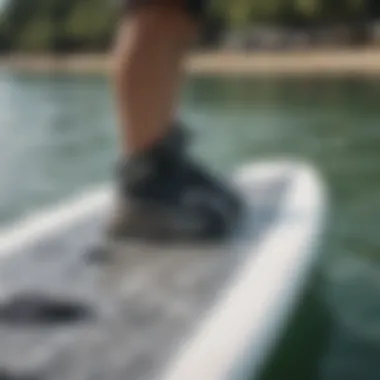
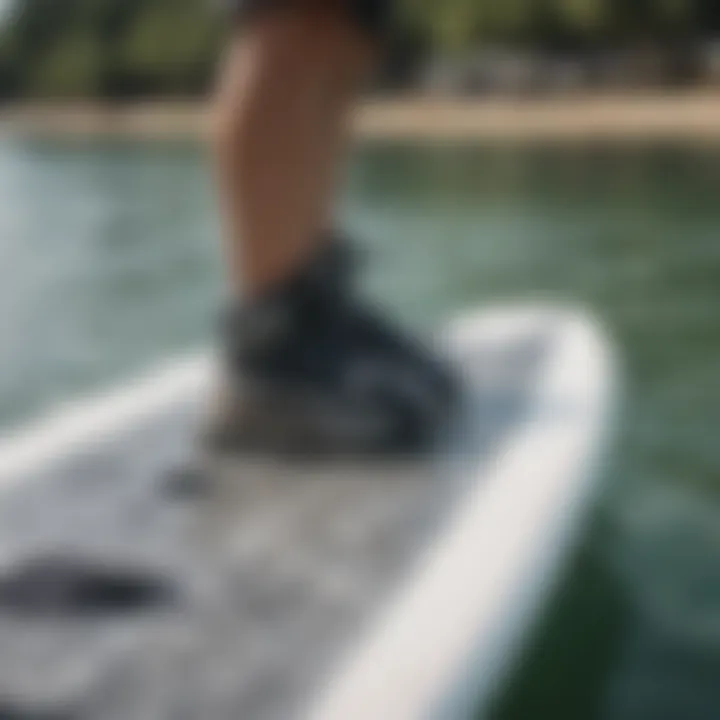
The cable system consists of lines and towers that run along the perimeter of the park. This component is integral as it powers the ride and maintains a smooth, continuous motion for all users.
- The key characteristic of the lines and towers setup is the uninterrupted circular or rectangular path they create. This allows for constant enjoyment without the need for a boat to circle back.
- One unique feature is how these towers are adjustable, which let operators alter the height and tension of the cable to tailor difficulty levels for riders depending on their skill.
- A bonus is that it encourages riders to take a leap, as they can practice repetitively without waiting on a boat. However, not every park’s installation is created equal, and some parks may have older systems that may present more challenges, like inconsistent speed.
Obstacles and Features
Obstacles are where the fun really begins. Most cable parks include ramps, rails, and sliders tailored to elevate the riding experience.
- The key characteristic of obstacles is that they add diversity and challenge to the ride. By mixing up the riding experience, they allow for creativity in tricks and maneuvers.
- A unique feature of these obstacles is that they are often modular, which means parks can change their layout, keeping the experience fresh. Riders get to improve their skills through trial and error on new setups regularly.
- The drawback here can include potential hazards, especially for novices not yet accustomed to approaching obstacles, which requires an understanding of timing and angles.
Safety Measures
Safety cannot be overlooked. Each cable park not only prioritizes the enjoyment of the sport but also establishes safety protocols.
- A key characteristic of the safety measures in place is that all riders must wear life jackets and helmets, minimizing the risk of injury. Parks often have staff dedicated to watching over riders and implementing safety briefings before they hit the water.
- One unique feature is the presence of throw ropes and lifeguards at strategic points making it easier to assist any riders in trouble.
- Nonetheless, there is a disadvantage in potential over-dependence on these measures, resulting in complacency among some riders, who feel overly secure in the controlled environment.
Benefits of Wakeboard Cable Parks
Cable parks have become a vital part of the wakeboarding landscape. The surge in their popularity can be traced to several core benefits, which appeal to both new enthusiasts and seasoned pros. Understanding these benefits not only highlights why one might choose a cable park over traditional wakeboarding but also paints a clearer picture of their role in enhancing the overall wakeboarding experience.
Accessibility for All Skill Levels
One of the standout features of cable parks is their ability to cater to a wide array of skill levels. Whether you’re just dipping your toes in the water or you’re already flipping and spinning through the air, there’s something at a cable park for everyone.
- Beginners can easily jump on a cable system and find themselves gliding across the water in no time. The progression from beginner to intermediate feels seamless, thanks to the adjustable tension on cables and the manageable speed, which can be tailored to the rider's comfort.
- Advanced riders can also find their playground here, with challenging obstacles and features that test and enhance their skills. The layout often includes various jumps, sliders, and rails which invite creativity and experimentation.
As the saying goes, "There’s something for everyone under the sun." This principle holds water in cable parks too, making them fantastic spots for groups with mixed skill levels.
Environmental Considerations
The conversation surrounding environmental stewardship holds significant weight in today’s world. Wakeboard cable parks generally use smaller engines than traditional motorized boats, which can lead to less pollution and looser regulatory landing. This aspect becomes crucial for waterway conservation.
- Electric systems are now leading the charge, reducing emissions and noise pollution. The feeling of slicing through a serene lake is far removed from the roar of a boat engine. Riders can enjoy nature’s beauty with minimal disruption.
- Furthermore, many parks adopt eco-friendly practices such as lakeside clean-ups and conservation programs, ensuring the surrounding environment remains pristine and inviting for everyone. It's not just about maintaining a fun place to ride; it’s about preserving a natural habitat for years to come.
"Sustainability isn’t a choice anymore; it's a necessity."
Cost-Effectiveness
When it comes down to the dollars and cents, cable parks often prove to be more economical than traditional boat wakeboarding.
- Affordability: The cost of a cable pass is usually lower than the expenses associated with renting a boat or hiring a captain, not to mention the ongoing fuel and maintenance costs. That extra bit of cash can add up, making cable parks much friendlier on the wallet.
- Unlimited Rides: Charging by the hour can sometimes lead to riders feeling pressured, but cable parks typically offer day passes for unlimited access. Riders can simply enjoy a full day's worth of water without worrying about additional fees.
By breaking down the barriers of cost, cable parks open the door for more individuals to engage in wakeboarding, creating a larger and more diverse community. In the end, saving a buck while catching some waves seems like a win-win.
Stitching together these benefits showcases that wakeboard cable parks are not just about the thrill of the sport, but also about creating an accessible, eco-friendly, and economically sustainable environment for all to enjoy.
Finding a Wakeboard Cable Park Near You
Identifying a wakeboard cable park nearby is crucial for every watersports enthusiast pursuing leisure or skill development. These parks provide a unique blend of accessibility, community, and tailored experiences. Whether you're just starting or looking to hone your techniques, understanding where to find a cable park can open a world of possibilities. It’s not just about riding the waves; it's about immersing yourself in a vibrant culture and making connections with fellow riders.
Using Online Resources
In today's digital age, numerous online tools simplify the task of finding cable parks that suit your needs. From comprehensive maps to active social media platforms, these resources are essential.
Map Services
Map services, such as Google Maps, play a vital role in locating cable parks. They provide a straightforward way to visualize the proximity of parks to your location. The ability to view directions directly can be whittled down to mere minutes. Around many cities, you can see reviews and photos, offering glimpses of what to expect.
The unique trait of map services is their real-time updates. Users can see park hours, user reviews, and even busiest times, making it a practical choice for planning your visit. However, it’s wise to cross-check with the official park website for the latest info, as not everything reliably sticks online.
Specialized Websites
Dedicated websites focusing on watersports and wakeboarding also serve as invaluable resources. Websites like Wakeboarding Magazine or WakePark Network compile parks from both local and international areas, making it a breeze to compare options. They usually feature articles, community stories, and even the latest trends in wakeboarding.
One thing that stands out is their comprehensive directory, which often includes filters like park amenities, skill levels, and even local events. The downside is that some of these sites may not always have the latest information, especially for new parks.
Social Media Groups
Social media platforms, particularly Facebook and Reddit, are great for direct engagement. You can find groups dedicated to wakeboarding enthusiasts where members share park recommendations, equipment advice, and riding tips. The interactive nature allows for real-time updates and personal anecdotes that you might not find in other media.
The strength of social media groups lies in their personal touch. Riders often share insider tips about locations, such as hidden parks not listed on directories. But do keep a level of skepticism, as posts can be subjective and heavily influenced by personal experiences.
Local Recommendations
Despite the vastness of online resources, local recommendations should never be underestimated. Often, the best insights can come from your community, through informal sources.
Community Bulletin Boards
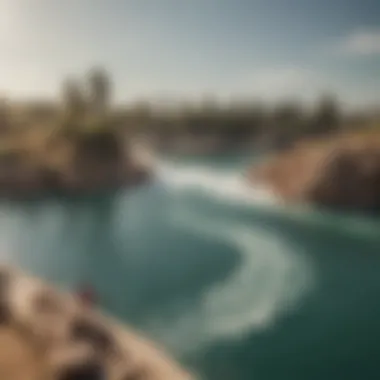
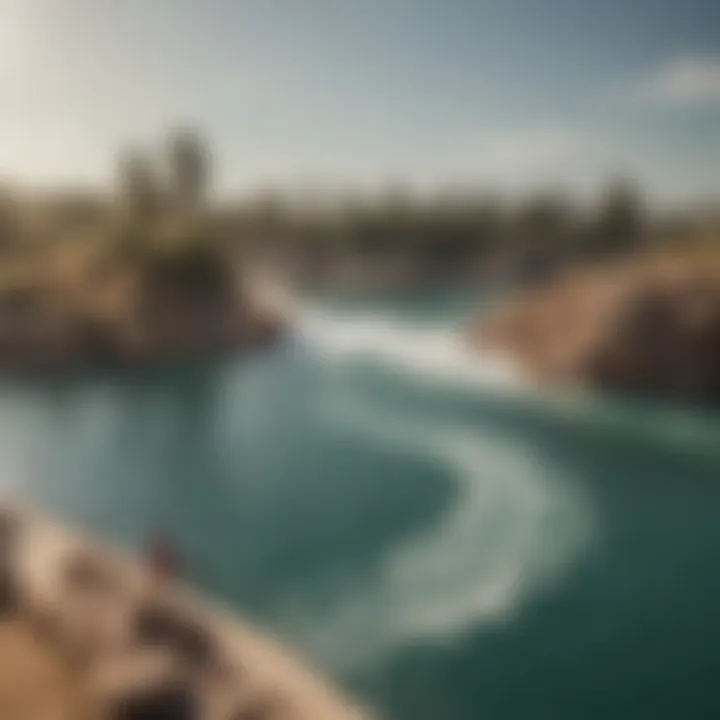
Community bulletin boards, often found in event spaces or coffee shops, can be treasure troves of information. Local riders post about their experiences, upcoming events, and even equipment sales. The sense of community shown through these postings adds an authentic layer to your search.
The key characteristic of these boards is their local feel; you’re absorbing information directly from others in your area. Plus, flyers often highlight special promotions, giving you a chance to discover new parks inexpensively. However, the downside may be inconsistencies, as postings may not be updated regularly.
Word of Mouth
Word of mouth remains one of the most valuable tools in finding hidden gems. Engaging with local watersports shops or active riders can lead to discovering lesser-known parks. The information provided tends to be reliable due to its basis in firsthand experience.
A notable strength of word of mouth is its personal nature, ensuring you get a flavor of each park from someone who’s been there. The risk, though, is that personal recommendations can be influenced by personal preferences, which may not align with your interests.
Events and Competitions
Participating in or attending local events and competitions gives you a real feel of the cable park culture. Not only do you witness talented riders, but you might also explore multiple parks in one go. These gatherings foster interaction between riders and provide insight into local favorites.
It's not only about watching; events often include community booths or information stands that allow you to gather further details. One trade-off is the potential crowding, which may not give you a full perspective of a park's usual environment. Even so, the energy and camaraderie often make the experience worthwhile.
Finding a cable park near you is not just about the ride; it's about the journey, the community, and the adrenaline rush that comes with thrilling experiences.
What to Expect at a Cable Park
When stepping into a wakeboard cable park, the initial feelings of excitement and anticipation can be palpable. Understanding what to expect can truly enhance your experience, making your time on the water all the more enjoyable. The environment is often buzzing with energy, as people from all walks of life—young or old, beginner or expert—gather to share their passion for water sports. This section delves into what newcomers should anticipate during their first visit and discusses equipment rentals, which play a crucial role in ensuring a smooth and comfortable ride.
The First Visit: An Overview
The first visit to a cable park can be like diving into the deep end—initially daunting but ultimately exhilarating. As you arrive, you will likely notice the layout, which usually comprises a cable system overhead, offering a continuous ride around a specially designed lake or a pond. The sound of water splashing and laughter creates a welcoming atmosphere, instantly making you feel part of a larger community.
Checking in at the reception is typically straightforward. Here, you'll sign waivers and receive information on park rules and procedures. It is wise to pay attention to this orientation because understanding the parks ground rules is critical for safety and enjoyment.
Once you’re all set, it’s time to hit the water. Many parks offer beginner lessons, and if you're new to wakeboarding, this is the best way to get started. Trainers are usually skilled professionals experienced not just in wakeboarding, but also in teaching basic techniques. It's recommended to take advantage of these lessons, as they'll prepare you with the foundational skills before you attempt the more thrilling maneuvers.
Equipment Rental and Gear
For those without gear or seeking to try new equipment, almost all cable parks offer rental services. This is critical because the right gear can significantly enhance your experience. Here’s a brief overview of what you might expect:
- Wakeboards: The design and size can vary. Beginners often use larger boards for better stability.
- Bindings: Make sure to get a snug fit as this is essential for control and comfort.
- Life Jackets: Safety should always be your top priority. Most parks mandate wearing a life jacket, and they will provide one if you need it.
Important Note: Always test gear before heading out onto the water. Comfort and fit are vital to a successful wakeboarding session.
If you're interested in purchasing gear, consulting with staff on recommended brands or models can be invaluable. Their insights can steer you towards quality options that suit your specific skill level and riding style.
"Safety first, fun second. Wakeboarding is a thrilling sport, but being equipped with the right knowledge and gear is what truly maximizes the enjoyment."
To sum it up, preparing for your first trip to a cable park involves a balance between welcoming excitement and an understanding of practical details. Whether it’s soaking in the vibrant atmosphere or gearing up for the waves, being well-informed will always come in handy.
Safety and Best Practices
When it comes to thrill-seeking watersports such as wakeboarding, safety is tantamount. Engaging with this adrenaline-fueled activity without the right precautions and practices can lead to significant injuries, not to mention take the fun out of a perfectly good day on the water. Understanding the importance of safety measures not only helps to prevent accidents but also fosters a positive atmosphere at cable parks, where riding etiquette and community spirit reign supreme.
Key Elements of Safety
Cable parks usually have a mix of beginners and seasoned riders, and as such, safety protocols should be adhered to by everyone. These include wearing proper safety gear, recognizing and abiding by park rules, and maintaining awareness of one's surroundings. If everyone keeps their head in the game, the experience can be enjoyable for all.
Understanding Safety Gear
Safety gear is not just an accessory; it's an essential component of the wakeboarding experience. Riders should arm themselves with the proper equipment before hitting the water. Here are the critical pieces:
- Life Vests
Wearing a properly fitted life vest can literally save your life. It’s crucial to choose a vest that is comfortable and rated for water sports, ensuring buoyancy while allowing for freedom of movement. - Wetsuits or Rash Guards
Depending on the weather, you might want to opt for a wetsuit. This not only keeps you warm but provides a protective layer against abrasions and rashes caused by the board or cables. - Helmets
While it might be tempting to skip the helmet for style points, a good helmet can absorb impact from falls. It’s worth considering that even experienced riders can have mishaps. - Impact Vests
These provide an additional layer of protection for your torso and can be particularly beneficial while executing tricks. - Bindings and Boards
Ensure bindings fit securely and boards are suitable for your skill level. A mismatch can lead to unwelcome surprises when you’re riding.
"Safety doesn’t come from what you wear, but from how you ride and respect the water."
Guidelines for Beginners
Entering the world of wakeboarding for the first time? You'll want to arm yourself with some guidelines to make the most of your experience while staying safe. Here are a few pointers to keep in mind:
- Start Slow
Begin with simple techniques and gradually progress as you feel more comfortable. Cable parks often allow learners to get the hang of the basics before jumping into complex maneuvers. - Listen to Instructors
If you’re new, take advantage of lessons. Instructors often share invaluable tips and standards that help in avoiding common pitfalls. - Observe Others
Before diving in, watch experienced riders. It gives you a sense of what to expect and how to prepare for various challenges in the water, such as navigating obstacles. - Be Aware of Conditions
Always check the park's conditions before you begin. High-traffic areas, changing weather, or technical difficulties on the cable system can affect your safety significantly. - Communicate
Let other riders know your skill level and intentions. This ensures everyone is on the same page, promoting a scenario where riders help each other out rather than compete against one another.
In summary, taking the time to understand and implement safety measures makes your wakeboarding experience much more enjoyable. With the right gear and an attitude that emphasizes safety, all riders—be they beginners or pros—can thrive in the vibrant world of cable parks.
Community and Culture at Cable Parks
In the world of wakeboarding, the community surrounding cable parks plays a pivotal role in shaping the overall experience for riders of all stripes. Unlike traditional boat wakeboarding, where the interactions often revolve around a handful of friends and family in a boat, cable parks build a bustling hub of like-minded enthusiasts. The atmosphere thrives on shared passions which creates not just a place to ride, but a culture that promotes growth and inclusivity for every skill level.
Fostering a Supportive Environment
At the heart of many cable parks is the desire to establish a supportive environment. New riders can sometimes feel like fish out of water, especially when surrounded by seasoned athletes executing jaw-dropping tricks. But, cable parks often seek to ease this transition. Many parks host instructors who specialize in teaching newcomers. This mentoring provides not only technical instruction but also instills confidence, ensuring that beginners feel cherished as part of the community.
Shared experiences on the cable also forge connections. Riders are often more than just users of the facility; they become part of a family. It’s not unusual to see someone offering a bit of advice to a fellow rider or cheering them on from the shore as they attempt their first jump. Events and group rides are commonplace. They foster camaraderie and a sense of belonging which resonates far beyond the water.
"Cable parks are like the neighborhood block party of the wakeboarding scene—everyone’s welcome, and it’s all about having a good time together."
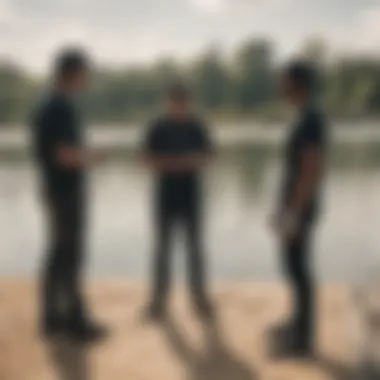

Events and Competitions
Events at cable parks aren’t just exciting—they're a highlight for many within the community. These happenings can vary from local competitions to international events that draw in top talent. Such events showcase diversity in skill and style, allowing all levels of riders to compete in the most relaxed atmosphere.
The excitement of a competition provides motivation. Many riders find themselves pushing beyond their limits just to catch their friends’ approval or to earn a sweet trophy. It's not just about the glory, though; it's about the memories forged during this shared experience.
- Types of Events
- Local competitions
- Freestyle showcases
- Category-based contests for different skill levels
At these events, spectators often become involved too, forming a vibrant audience that joins in with loud cheers and encouragement. Food stalls and merchandise turns these gatherings into all-day affairs, blending the spirit of competition with a carnival atmosphere. Such events become staples in the community calendar, where riders can come together to celebrate not just their achievements, but the sport itself.
Comparing Cable Parks to Boat Wakeboarding
When it comes to the world of wakeboarding, the debate between cable parks and traditional boat wakeboarding often ignites passionate discussions. Each has its own charm, experiences, and stipulations, making it essential for enthusiasts—from first-timers to seasoned pros—to grasp the differences. This understanding helps in selecting the right environment to satisfy one's craving for adrenaline.
Differences in Experience
Engaging in wakeboarding at a cable park diverges significantly from being towed behind a boat. In a cable park, the system is continuous; riders are propelled by overhead cables, allowing many individuals to ride in a line. This setup promotes an environment where learners can refine their skills without the frequent interruptions that usually come with boat rides. Imagine standing on a floating platform, watching others ride, and quickly adjusting your technique based on what you observe. It creates a community feel.
On the flip side, when wakeboarding behind a boat, you have the thrill of speed and the ability to change the surroundings at will. A boat can take you to different bodies of water, offering an ever-changing backdrop that cable parks cannot replicate. However, this experience can lack the vibrancy of camaraderie since you might spend more time waiting for your turn, leading to a more solitary venture.
One notable element is how obstacles present at cable parks can elevate the experience. Many parks include ramps, rails, and diverse features that challenge riders in ways that a boat trip might not. Beginners can practice approaching and landing tricks with no fear of falling in front of a crowd, while advanced riders can experiment with innovative movements without the constraints of space typical in boat settings.
Cost Analysis
When analyzing the costs associated with cable parks versus boat wakeboarding, the clear disparity becomes apparent. Cable parks often offer a pay-per-ride or day-pass system, frequently making it a more budget-friendly option. Many places even have discounts for students or families, making it accessible for broader audiences. On average, a day pass at a cable park is normally cheaper than the collective cost of renting a boat, gas, and maintaining equipment for a day on the water.
In contrast, the upkeep of a boat can lead to ongoing expenses that pile up over time, including maintenance, insurance, and storage fees. Plus, the need for a qualified driver to manage the boat complicates arrangements—those extra hands can lead to more costs.
Summary
To sum it up, choosing between a cable park and boat wakeboarding depends heavily on what an individual seeks from the experience. Cable parks shine with affordability, community, and access to various obstacles for practice, while boat wakeboarding offers flexibility in location and speed. Ultimately, both have unique attributes that appeal to different aspects of wakeboarding, and understanding these distinctions enables participants to make an informed decision about where they wish to hit the waves.
Adapting to Different Skill Levels
When it comes to wakeboard cable parks, the notion of skill levels is central to the experience. Every individual, whether fresh out of their first class or a seasoned rider pulling off aerial flips, has a place in the cable park setup. The beauty of these parks lies in their inclusivity, allowing riders to adapt and grow at their own pace. A significant element is the ability for beginners and advanced riders to experience the same park under varying conditions, all while utilizing tailored techniques and appropriate equipment. This creates an environment rich in learning and growth.
As previously mentioned, understanding different skill levels promotes safety and enhances enjoyment. The parks often feature diverse obstacles, from beginner-friendly sliders to challenging kickers, letting riders progressively tackle tougher challenges. This layered approach nurtures confidence in riders while fostering community, as newcomers often find support from veterans willing to share their experiences and tips.
Beginner Lessons and Tips
For those just starting, lessons are crucial. Beginner riders tend to feel overwhelmed, but here’s where cable parks shine. Parks frequently offer instructional courses tailored for novices. These sessions often last an hour or two and focus on the fundamentals — handling the tow system, basic riding stance, and simple tricks.
Some key points to keep in mind include:
- Equipment Fit: Make sure the harnesses and boards suit your size and experience level. Incorrect gear can lead to injury or frustration.
- Start Slow: It’s easy to get carried away with enthusiasm, but starting with easier obstacles and gradually progressing is best. Your body will thank you.
- Learn from Others: Don’t hesitate to ask more experienced riders for advice. Most people are keen to help and share their journey.
In terms of tips, consider practicing balancing exercises on the shoreline. Strengthen your core, and don’t shy away from the idea of falling; it’s all part of the learning process!
Advanced Techniques and Tricks
For the seasoned wakeboarder, developing technical skills and mastering tricks can turn into a personal quest. Advanced riders best benefit from taking risks within their comfort zones. The rhythm of the cable allows you to practice repetitively without the need to arrange boat towing, which can be a game-changer.
The focus here is often on perfecting tricks like spins, jumps, or rail slides. Here are some pointers for aspiring tricksters:
- Visualize Success: Imagining yourself executing a trick perfectly can improve your confidence. It’s not just mental; it often translates into performance.
- Break it Down: Don't try to conquer a trick in one go. Separate the elements, so if you're looking at a backflip, ensure you can manage the rotation first.
- Record Your Sessions: Capturing your sessions on video provides valuable feedback. Noticing your stance and movements can help adjust and refine techniques.
Coming together at cable parks means exchanging ideas, tips, and challenges. This knowledge-sharing creates an ever-evolving culture of innovation in the wakeboarding community.
For wakeboarders, mastering skills at different levels is more than just individual growth; it’s about fostering a community of shared knowledge and experience across the water.
Culmination: The Future of Wakeboarding
The future of wakeboarding hinges not just on the sport's evolution but also on the venues in which it thrives. Cable parks, in particular, are paving the way for a more inclusive and sustainable watersport experience. With various trends emerging in the industry, it’s crucial to grasp the endgame some might argue:
- Accessibility and Inclusiveness: As wakeboarding becomes more popular, cable parks are designed to be user-friendly for everyone, whether you’re a toddler or a retiree. This opens doors to a broader demographic, allowing those who may not have had access to traditional boat wakeboarding to join in the fun. And let’s be honest—nothing builds community like a group of eager learners cheering each other on.
- Sustainability Initiatives: Increasing awareness around environmental concerns translates into more eco-conscious facilities. Many cable parks are now adapting to sustainable practices, reducing energy consumption and utilizing eco-friendly materials in their construction. It’s a trend that not only draws in eco-minded riders but also shifts the entire industry towards better environmental stewardship.
- Technological Advancements: New technologies in equipment and cable systems are improving the wakeboarding experience. From enhanced safety features to innovative obstacles, these advancements only serve to attract more enthusiasts.
Trends in Watersports
The watersport landscape is changing, and wakeboarding is no exception. Here are a few notable trends:
- Rise of Electric Cable Systems: Many parks are now exploring electric systems that reduce noise and carbon footprints while maintaining optimal cable speed. This means better consistency in rider experience and a quieter park for spectators.
- Diverse Offerings: Cable parks are not just for wakeboarding anymore; many are blending different watersports such as wakesurfing, kneeboarding, and paddleboarding. This creates a true watersport playground, appealing to a wider audience and maximizing usability.
- Focus on Community Events: Increasingly, parks are organizing competitions and gatherings that focus not just on skill but also on fostering a culture of camaraderie. Think social meetups, charity events, and local competitions that give riders a chance to showcase their skills and enjoy the community vibe.
The Role of Cable Parks in the Industry
Cable parks are not simply an alternative to traditional wakeboarding; they’re shaping the future of the sport:
- Innovation and Experimentation: These parks provide an environment for riders to experiment with new tricks in a controlled setting, enabling them to push boundaries in ways they might not feel comfortable doing behind a motorboat.
- Nurturing Talent: Many professional wakeboarders hail from incredible cable parks where they’ve honed their skills. These parks cultivate talent from beginners to advanced riders, giving them a platform to grow within the sport.
- Economic Impact: By generating local tourism and providing job opportunities, cable parks help in economic contributions to their communities. More riders mean more lessons, rentals, and food at the park's café, which all trickle down to benefit the local economy.
"Cable parks are not just facilities; they are the lifeboats steering wakeboarding into an inclusive, sustainable future."
As we continue exploring the impact of these parks, it becomes evident they will play a significant role in shaping the trajectory of wakeboarding as we know it. More activities, more participants, and more sustainable practices equate to a brighter future for watersports.



